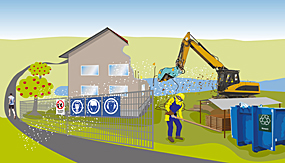
© SYKE
Finland aims to promote circular economy as part of the mitigation of the climate crisis and the sustainable use of natural resources. However, problems for the health of people or the environment must be avoided in the transfer towards a circular economy. The Safe and sustainable circular economy – SIRKKU project observed that the flow of information about hazardous substances in circular economy must be improved, and technologies developed to ensure that these substances are not returned to use in the new products.
Methods for the identification of chemicals must also be developed, as well as new materials to reduce the use of hazardous chemicals. Hazardous materials should also be replaced with less hazardous ones and technologies. Training and guidance are required for operators in various fields for the identification, processing, and disposal of hazardous substances.
Particular attention to construction waste
The SIRKKU project sought sectors of circular economy where the management of chemicals must be improved. Persistent organic pollutants (POPs) and substances of very high concern (SVHC substances) were examined.
“One significant aim was to achieve dialogue with representatives of the fields and examine what kinds of support businesses would need in order to improve their management of chemicals as their operating environment changes from linear towards circularity. Particularly the hazardous substances contained by construction waste were examined. However, the recommendations issued based on the report apply to all fields, not only the construction field”, says the leader of the project, Senior Research Scientist Sari Kauppi from the Finnish Environment Institute (SYKE).
“Particular attention must be paid to the risks caused to the employees by chemicals contained in recycled materials in waste management and the repair and demolishing fields. Harmful substances must not be allowed to spread to the environment. Designing safe operating methods and technical protective actions are the primary means of risk management. Personal protection must be used if the spreading of harmful substances cannot otherwise be avoided”, emphasises Senior Expert Sirpa Laitinen from the Finnish Institute of Occupational Health (THL).
Eco-design must be promoted
Chemical information should be carried along with the product throughout its life cycle.
The design of products is essential for this. Reuse, serviceability, and recyclability should be considered in product design, as well as selecting materials and substances which are harmless to health and the environment. Innovation policies could support the development of new materials which meet the requirements of circularity.
Read more
More information
- Senior Research Scientist Sari Kauppi, Finnish Environment Institute, firstname.lastname@ymparisto.fi